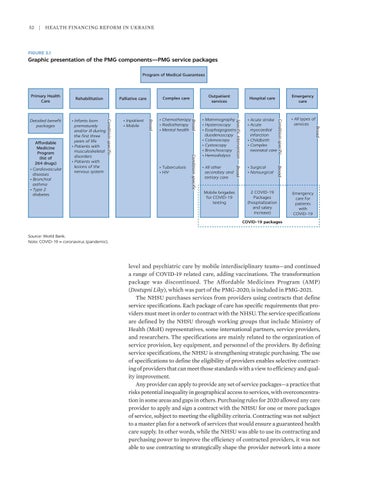52
| Health Financing Reform in Ukraine
FIGURE 3.1
Graphic presentation of the PMG components—PMG service packages Program of Medical Guarantees
Hospital care
Emergency care
• Infants born prematurely and/or ill during the first three years of life • Patients with musculoskeletal disorders • Patients with lesions of the nervous system
• Inpatient • Mobile
• Chemotherapy • Radiotherapy • Mental health
• Mammography • Hysteroscopy • Esophagogastro duodenoscopy • Colonoscopy • Cystoscopy • Bronchoscopy • Hemodialysis
• Acute stroke • Acute myocardial infarction • Childbirth • Complex neonatal care
Conditioin specific
• All types of services
• All other secondary and tertiary care
Broad
• Surgical • Nonsurgical
Broad
Conditioin specific
• Tuberculosis • HIV
Mobile brigades for COVID-19 testing
2 COVID-19 Packages (hospitalization and salary increase)
Broad
Outpatient services
Broad
Complex care
Broad
Affordable Medicine Program (list of 264 drugs) • Cardiovascular diseases • Bronchial asthma • Type 2 diabetes
Palliative care
Conditioin specific
Detailed benefit packages
Rehabilitation
Specific intervention
Primary Health Care
Emergency care for patients with COVID-19
COVID-19 packages Source: World Bank. Note: COVID-19 = coronavirus (pandemic).
level and psychiatric care by mobile interdisciplinary teams—and continued a range of COVID-19 related care, adding vaccinations. The transformation package was discontinued. The Affordable Medicines Program (AMP) (Dostupni Liky), which was part of the PMG-2020, is included in PMG-2021. The NHSU purchases services from providers using contracts that define service specifications. Each package of care has specific requirements that providers must meet in order to contract with the NHSU. The service specifications are defined by the NHSU through working groups that include Ministry of Health (MoH) representatives, some international partners, service providers, and researchers. The specifications are mainly related to the organization of service provision, key equipment, and personnel of the providers. By defining service specifications, the NHSU is strengthening strategic purchasing. The use of specifications to define the eligibility of providers enables selective contracting of providers that can meet those standards with a view to efficiency and quality improvement. Any provider can apply to provide any set of service packages—a practice that risks potential inequality in geographical access to services, with overconcentration in some areas and gaps in others. Purchasing rules for 2020 allowed any care provider to apply and sign a contract with the NHSU for one or more packages of service, subject to meeting the eligibility criteria. Contracting was not subject to a master plan for a network of services that would ensure a guaranteed health care supply. In other words, while the NHSU was able to use its contracting and purchasing power to improve the efficiency of contracted providers, it was not able to use contracting to strategically shape the provider network into a more

